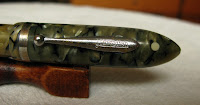 Súper T ad from 1948. On the left hand side it reads that there are 20 different nibs available for this pen with "everlasting guarantee". Advertisement collected by Grafopasión member Claudio.
Súper T ad from 1948. On the left hand side it reads that there are 20 different nibs available for this pen with "everlasting guarantee". Advertisement collected by Grafopasión member Claudio.  In 1934 the Kaweco Sport could have up to twelve different nibs. Image taken from the Kaweco website (December 2010).
In 1934 the Kaweco Sport could have up to twelve different nibs. Image taken from the Kaweco website (December 2010). Those are only two examples of the wealth of nib possibilities in former times. Nowadays, the options are mostly reduced to the typical F, M and B triad, and, if anything else, some oblique nibs catering the snobbish rather than any real writing need. The main exception to this observation are the big three Japanese companies and their interesting nib catalog.
 Cross nib by Sailor. My thanks to Mr. Noguchi, of the Wagner Association in Japan. Some other nibs by Sailor can be seen on the British Sailor website.
Cross nib by Sailor. My thanks to Mr. Noguchi, of the Wagner Association in Japan. Some other nibs by Sailor can be seen on the British Sailor website.  Three music nibs by two Japanese companies: Platinum on the top, and Pilot on sizes 5 and 10. Platinum's nib selection is a lot more reduced than Pilot's. Its sister company Nakaya has some additional points, including a stub.
Three music nibs by two Japanese companies: Platinum on the top, and Pilot on sizes 5 and 10. Platinum's nib selection is a lot more reduced than Pilot's. Its sister company Nakaya has some additional points, including a stub.Now I wonder what the real reasons for this were. Is it just a matter of supply and demand? Might it be a result of pens being more of a collectible object than a real writing tool?
I have no answers. I do know, however, that I find fewer and fewer interesting features in modern pens and, consequently, I turn my face to vintage pens.










































